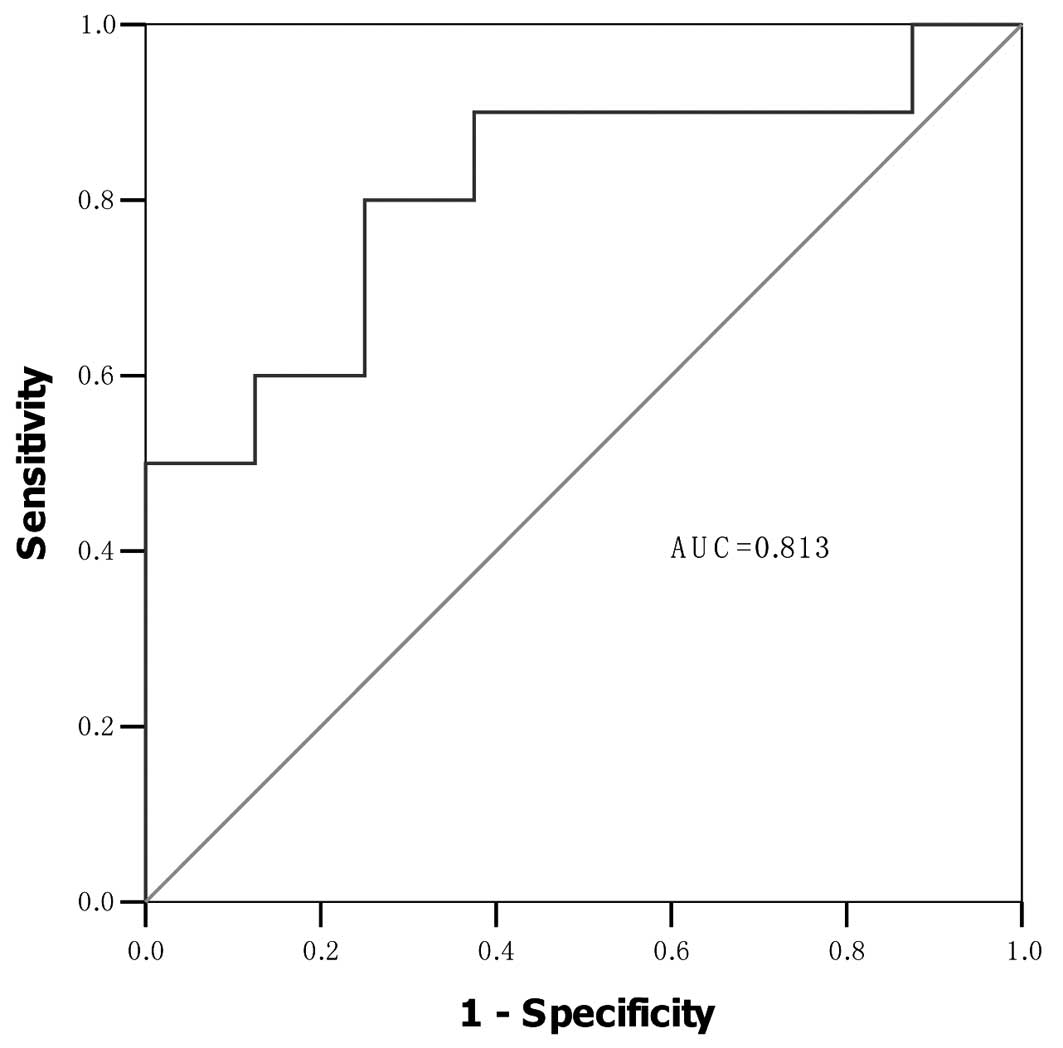|
1
|
Simon L, Gauvin F, Amre DK, Saint-Louis P
and Lacroix J: Serum procalcitonin and C-reactive protein levels as
markers of bacterial infection: a systematic review and
meta-analysis. Clin Infect Dis. 39:206–217. 2004. View Article : Google Scholar : PubMed/NCBI
|
|
2
|
Tang BM, Eslick GD, Craig JC and McLean
AS: Accuracy of procalcitonin for sepsis diagnosis in critically
ill patients: systematic review and meta-analysis. Lancet Infect
Dis. 7:210–217. 2007. View Article : Google Scholar : PubMed/NCBI
|
|
3
|
Young L: Gram-negative sepsis. Principles
and Practice of Infectious Diseases. Mandell GL, Douglas RG and
Bennett JE: Churchill Livingstone; New York: pp. 611–636. 1990
|
|
4
|
Chen X, Ba Y, Ma L, et al:
Characterization of microRNAs in serum: a novel class of biomarkers
for diagnosis of cancer and other diseases. Cell Res. 18:997–1006.
2008. View Article : Google Scholar : PubMed/NCBI
|
|
5
|
Mitchell PS, Parkin RK, Kroh EM, et al:
Circulating microRNAs as stable blood-based markers for cancer
detection. Proc Natl Acad Sci USA. 105:10513–10518. 2008.
View Article : Google Scholar : PubMed/NCBI
|
|
6
|
McDonald JS, Milosevic D, Reddi HV, Grebe
SK and Algeciras-Schimnich A: Analysis of circulating microRNA:
preanalytical and analytical challenges. Clin Chem. 57:833–840.
2011. View Article : Google Scholar : PubMed/NCBI
|
|
7
|
Ho AS, Huang X, Cao H, et al: Circulating
miR-210 as a novel hypoxia marker in pancreatic cancer. Transl
Oncol. 3:109–113. 2010. View Article : Google Scholar : PubMed/NCBI
|
|
8
|
Taganov KD, Boldin MP, Chang KJ and
Baltimore D: NF-kappaB dependent induction of microRNA miR-146, an
inhibitor targeted to signaling proteins of innate immune
responses. Proc Natl Acad Sci USA. 103:12481–12486. 2006.
View Article : Google Scholar : PubMed/NCBI
|
|
9
|
Hou J, Wang P, Lin L, et al: MicroRNA-146a
feedback inhibits RIGI-dependent type I IFN production in
macrophages by targeting TRAF6, IRAK1 and IRAK2. J Immunol.
183:2150–2158. 2009. View Article : Google Scholar : PubMed/NCBI
|
|
10
|
Pauley KM, Satoh M, Chan AL, Bubb MR,
Reeves WH and Chan EK: Upregulated miR-146a expression in
peripheral blood mononuclear cells from rheumatoid arthritis
patients. Arthritis Res Ther. 10:R1012008. View Article : Google Scholar : PubMed/NCBI
|
|
11
|
Wang JF, Yu ML, Yu G, Bian JJ, Deng XM,
Wan XJ and Zhu KM: Serum miR-146a and miR-223 as potential new
biomarkers for sepsis. Biochem Biophys Res Commun. 394:184–188.
2010. View Article : Google Scholar : PubMed/NCBI
|
|
12
|
Bone RC, Balk RA, Cerra FC, et al:
Definitions for sepsis and organ failure and guidelines for the use
of innovative therapies in sepsis. Chest. 101:1644–1655. 1992.
View Article : Google Scholar
|
|
13
|
Levy MM, Fink MP, Marshall JC, et al: 2001
SCCM/ESICM/ACCP/ATS/SIS International Sepsis Definitions
Conference. Crit Care Med. 31:1250–1256. 2003. View Article : Google Scholar : PubMed/NCBI
|
|
14
|
No authors listed. American College of
Chest Physicians/Society of Critical Care Medicine Consensus
Conference: definitions for sepsis and organ failure and guidelines
for the use of innovative therapies in sepsis. Crit Care Med.
20:864–74. 1992. View Article : Google Scholar
|
|
15
|
Dellinger RP, Levy MM, Carlet JM, et al:
Surviving sepsis sampaign: international guidelines for management
of severe sepsis and septic shock: 2008. Crit Care Med. 36:296–327.
2008. View Article : Google Scholar
|
|
16
|
Shapiro NI, Wolfe RE, Moore RB, Smith E,
Burdick E and Bates DW: Mortality in Emergency Department Sepsis
(MEDS) score: a prospectively derived and validated clinical
prediction rule. Critical Care Medicine. 31:670–675. 2003.
View Article : Google Scholar : PubMed/NCBI
|
|
17
|
Takeuchi O, Hoshino K, Kawai T, et al:
Differential roles of TLR2 and TLR4 in recognition of Gram-negative
and Gram-positive bacterial cell wall components. Immunity.
11:443–451. 1999. View Article : Google Scholar : PubMed/NCBI
|
|
18
|
Vasilescu C, Rossi S, Shimizu M, et al:
MicroRNA fingerprints identify miR-150 as a plasma prognostic
marker in patients with sepsis. PLoS One. 4:e74052009. View Article : Google Scholar : PubMed/NCBI
|
|
19
|
Nahid MA, Pauley KM, Satoh M, et al:
miR-146a is critical for endotoxin-induced tolerance, implication
in innate immunity. J Biol Chem. 284:34590–34599. 2009. View Article : Google Scholar : PubMed/NCBI
|
|
20
|
Formisano-Treziny C, de San Feliciano M
and Gabert J: Development of plasmid calibrators for absolute
quantification of miRNAs by using real-time qPCR. J Mol Diagn.
14:314–321. 2012. View Article : Google Scholar : PubMed/NCBI
|
|
21
|
Hromadnikova I, Kotlabova K, Doucha J,
Dlouha K and Krofta L: Absolute and relative quantification of
placenta-specific micrornas in maternal circulation with placental
insufficiency-related complications. J Mol Diagn. 14:160–167. 2012.
View Article : Google Scholar
|
|
22
|
Pu XX, Huang GL, Guo HQ, et al:
Circulating miR-221 directly amplified from plasma is a potential
diagnostic and prognostic marker of colorectal cancer and is
correlated with p53 expression. J Gastroenterol Hepatol.
25:1674–1680. 2010. View Article : Google Scholar : PubMed/NCBI
|
|
23
|
Tomasetti M, Staffolani S, Nocchi L, et
al: Clinical significance of circulating miR-126 quantification in
malignant mesothelioma patients. Clin Biochem. 45:575–581. 2012.
View Article : Google Scholar : PubMed/NCBI
|
|
24
|
Zhang Y, Jia Y, Zheng R, et al: Plasma
microRNA-122 as a biomarker fro viral-, alcohol- and
chemical-related hepatic diseases. Clin Chem. 56:1830–1838. 2010.
View Article : Google Scholar : PubMed/NCBI
|
|
25
|
Starkey Lewis PJ, Dear J, Platt V, et al:
Circulating microRNAs as potential markers of human drug-induced
liver injury. Hepatology. 54:1767–1776. 2011.PubMed/NCBI
|
|
26
|
Gui J, Tian Y, Wen X, et al: Serum
microRNA characterization identifies miR-885-5p as a potential
marker for detecting liver pathologies. Clin Sci (Lond).
120:183–193. 2011. View Article : Google Scholar : PubMed/NCBI
|













